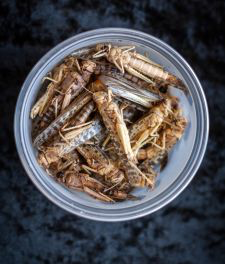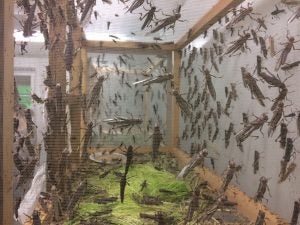In certain parts of the world, grasshoppers are known as a delicious delicacy, and insects are eaten by 2.5 billion people annually. The first country that comes to mind for you may be Mexico, where “Chapulines” is Spanish for grasshopper and is very popular, cooked in a variety of ways.

The problem is that grasshoppers are not really available year round and are caught in the wild or in farmer’s fields; they’re not available as a grocery-store item, unlike crickets which can be a little easier to find on store shelves.
Until now. Recently at the #One17 Alltech ideas conference, I met Dror Tamir, founder of Hargol Foodtech — the worlds first commercial grasshopper farm. The company has raised approximately a million dollars for the startup, which plans on getting its grasshopper products all around the world to fill the demand for insect-based protein. Traditionally one of the downfalls of grasshoppers is that the incubation time for eggs was 40 weeks, but Hargol found a way to shorten the incubation period down to two to four weeks. He and his team have been able to increase the number of life cycles from one per year to 10.
The grasshopper farm has been modeled after the poultry industry, with some grasshoppers used only for breeding and the offspring used for market. The grasshoppers go to market at around 30 days or so and can reach about 2 inches in length. When they’re market ready they are “put to sleep” literally by freezing them. They are raised indoors in vertical cages stacked floor to ceiling in climate-controlled rooms that measure about 30 square meters. The facilities also contain vertical walls of hydroponically grown wheat grass, while outside sources are also used to supply mature grasses as feed.

This jokingly makes me wonder if people will start demanding the grasshoppers be raised “grass fed, free range, and cage free?” But seriously, my hats off to them for supplying something different. These types of insect are also halal and kosher, which is good for the Israeli-based company. Companies such as Whole Foods in the U.S. have also expressed interest.
But what do you think? Can consumers shrug off the “ick” factor? Personally, I was turned off at first but am slowly opening my mind to the thought of trying them. After all, we as humans eat all sorts of weird things like shrimp, prawns, octopus, and crawfish. Why should these creatures be any different? Time will tell how people react, especially here in our American culture.
As mentioned earlier, products like cricket chips or protein powder have risen in popularity; however grasshoppers are apparently more rich in protein and other nutrients and also more logically reasonable to raise in a farmed environment partly considering they swarm in nature. Another benefit is that they’re neutral in taste, which means they’re versatile for cooking and different types of recipes can provide many different flavor variations.

Keep your eyes peeled for the trend and see if you can spot these nutritious little buggers in your local grocer soon. This is one step forward for mankind, but a leap forward for the grasshopper.
Michelle Miller, the Farm Babe, is an Iowa-based farmer, public speaker and writer, who lives and works with her boyfriend on their farm which consists of row crops, beef cattle, and sheep. She believes education is key in bridging the gap between farmers and consumers.



